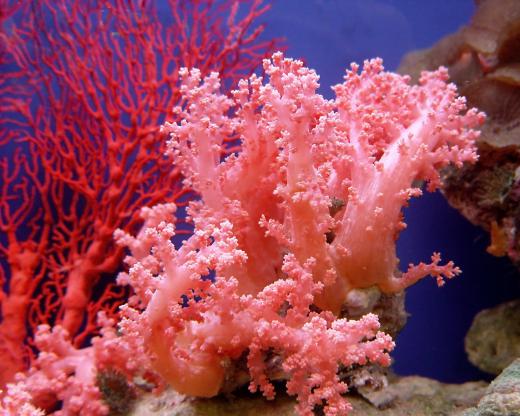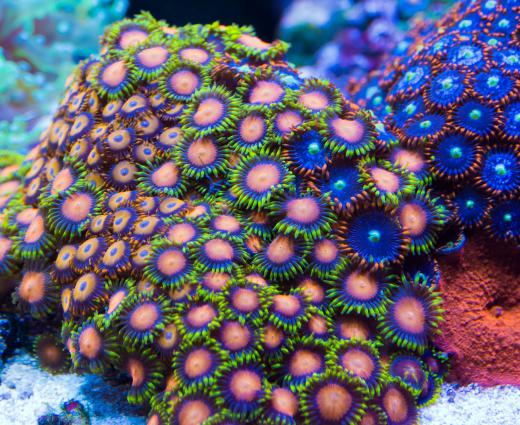What is the Difference Between Sponges and Coral?
 Michael Anissimov
Michael Anissimov
Superficially, sponges and coral have a lot in common. They both just sit there underwater, filtering food particles, living in large colonies that provide habitats for other animals. Divers know that they come in many beautiful colors. But below the surface, these two organisms are completely different.
Sponges and coral come from different animal phyla, for one. Phyla is the most basic of all animal distinctions, and refers to animals with completely different body plans. Sponges are among the most simple of all animals, lacking true tissues, and deterring predators primarily by their lack of nutrition and glass-like shards found in their bodies called spicules. They are covered in little pores lined with cells equipped with flagella, which are both used to circulate water through the sponge and absorb food particles. Sponges are capable of living at any point in the ocean, from just off the shore to 8,500 m (29,000 ft) deep, or more. Sponges are members of phylum Porifera, and their alternate name is "poriferans."

Corals are cnidarians, related to jellyfish and anemones. More complex than sponges, they have differentiated tissue and a true gut. Corals look like single individuals, but they are in fact huge colonies composed of numerous genetically identical polyps just a few millimeters in diameter. These polyps have stinging tentacles, which is characteristic of cnidarians. Instead of depending on food particles for food, corals get most of their nutrition from symbiotic algae, which gives them their color. Corals cannot live as deep as sponges, most being found in the photic zone, where light can reach their algae, but some species are found at depths of 3000 m (9,842 ft).

Sponges and coral are both members of very early lineages that probably split off from other animals as early as 600 million years ago. For a very long time, it was thought that sponges were the most basal of sponges and coral, but recent genetic studies have indicated that the ancestors of coral, early cnidarians, actually split off from other animals first, and that sponges are likely from a lineage that was secondarily simplified.
AS FEATURED ON:
AS FEATURED ON:












Discussion Comments
@submariner- I never knew that the pet market had such an influence on coral reefs, sponges, tropical fish and other shallow water organisms. I wonder why many of these fish and reef creatures cannot be bred in captivity. This seems like an easier and less environmentally damaging way of supplying people with aquarium animals.
@PelesTears- Damage to coral reefs is widespread. I read that coral reefs support somewhere around 25% of all ocean life, and almost a billion people depend on the bounty of reefs for subsistence living. What baffles me the most is humans do most of the damage to the reef. In many cases, the humans damaging the reefs depend on the reef for income.
The perfect example is the damage caused to reefs by cyanide fishing in Southeast Asia. Somewhere around half of all tropical reef fish sold for aquarium are caught using cyanide-fishing techniques. Anglers use sodium cyanide to stun the fish so they can be collected for retail sale. The trouble with this is that cyanide kills the coral and sea sponge polyps by preventing the zooxanthellae from photosynthesizing. Essentially, the coral become starved, causing sporadic bleaching and reef death. This causes the fish to flee the area, thus reducing yields of aquarium fish. This vicious cycle does no good for anyone except for the large chain pet stores that can offer tropical reef fish for cheap prices.
What is happening to the coral reefs across the world? I recently went to Australia and I was saddened to see that some of the reefs we visited were dull and lifeless. There was little color to the coral, and huge spiny starfish overran them. I was disappointed because this area of the world is supposed to have some of the best reefs in the world.
Do not get me wrong, most of the places I dove and snorkeled were absolutely beautiful, but I was still sad to see all the damage. I asked the guide what caused all of this, and he said it was a number of things. He also said it was happening in other places around the world, not just on the barrier reef. He said reefs in the Caribbean, pacific, and Southeast Asia were all suffering for various reasons.
Post your comments